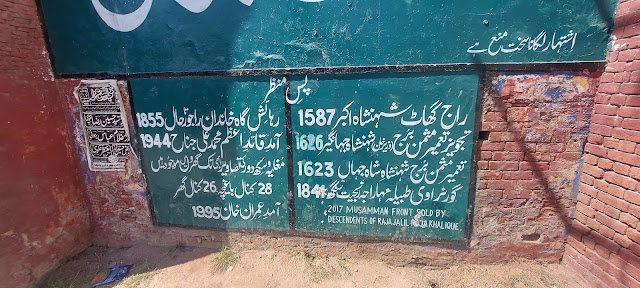23rd April 2023
(All images copyright 2023 Mirza Ali Usman Baig, text written in this article is the author's Research and shouldn't be reproduced)
Sheikh
Niaz Ahmed's Mansion: A Testament to Hindustan's Rich Heritage
Introduction:
In
the era of British rule in Hindustan, only two tanneries dotted the country's
landscape, one of which was in Cawnpore and the other in Wazirabad. Under the
astute administration of Sheikh Niaz Ahmed, the Wazirabad Tannery thrived. Not
only was Sheikh Niaz a prominent figure in the leather industry, but he also
hailed from Wazirabad and erected a magnificent mansion for himself, a
testament to his success and stature. Completed in 1929 at a cost of one Lac
rupees, this mansion, known as 'Sheikh wali Khoti,' still stands proudly on Lt.
Arif Shaheed Road, across from the city courts.
Architectural
Grandeur:
The two-story mansion exudes an aura of grandeur and opulence, reminiscent of a palace. Elaborate lancet arches in the Gothic style grace the front arcade on the ground floor, accentuating its elegance. A majestic Victorian-style porch occupies the central portion of the facade, capturing the attention of all who pass by. The meticulous craftsmanship is evident in the use of English bond bricks, which lend strength and structure to the building. Intricate column ribs and an ornate exterior cornice, all meticulously designed with elegant cut bricks, further embellish the mansion's exterior.
A Fusion of Architectural Styles:
The
mansion is a prime example of Indo-Saracenic architecture, a style that emerged
and gained prominence during the colonial period in India. This architectural
blend masterfully incorporates elements from Indian, Islamic, and European
styles. Oval-shaped ventilators, a common feature in colonial architecture to
ensure ventilation in hot and humid climates, are also present in the mansion's
front elevation. The first floor boasts rectangular windows and square
ventilators, both adorned with curved tops. Such intricate detailing highlights
the seamless fusion of various architectural influences.
A
Testament to the Changing Landscape:
According
to our local host, a resident of Wazirabad, the mansion was once surrounded by
a vast jungle that has since been lost to the march of urbanization. The
concrete jungle has replaced the natural beauty that once enveloped the estate.
Adjacent to the mansion, in a state of disrepair, lie the servant quarters and
a mosque that Sheikh Niaz himself constructed, reflecting the passage of time
and neglect.
Sheikh
Niaz Ahmed: A Man of Honor:
Sheikh
Niaz Ahmed was renowned for his unwavering integrity and expertise in the
leather industry. His dedication earned him the respect of the British, who
recognized his contributions by presenting him with a watch as a token of
appreciation. In due course, he was bestowed with the title of honorary
magistrate by the Queen of Britain, further cementing his reputation. When
Sheikh Niaz passed away, the British newspaper's headline the following day
read, "The King of Leather has died," a testament to his prominence and
the impact he had made in his field.
Legacy
and Remembrance:
Years
later, after the formation of Pakistan, Sheikh Niaz's son, Arif, sacrificed his
life in the 1971 war. In honor of his gallantry and sacrifice, the road in
front of the mansion was named "Lt. Arif Shaheed Road." This poignant
tribute perpetuates the memory of Sheikh Niaz's family's sacrifices and their
contributions to the nation.
Unspoken
Stories of Wazirabad's Illustrious Past:
Known
among the commoners of Wazirabad as 'Sheikh wali Khoti,' this magnificent
mansion encapsulates the rich and storied history of the city. It stands as a
testament to the bygone era of Hindustan's grandeur and Sheikh Niaz Ahmed's
enduring legacy. Concealed within its walls are untold stories of triumph,
heritage, and the fusion of cultures that shaped the region's history.
Conclusion:
Sheikh
Niaz Ahmed's mansion in Wazirabad stands as a testament to the grandeur of
Hindustan's past. Its architectural magnificence, blending elements of Indian,
Islamic, and European styles, is a remarkable example of Indo-Saracenic
architecture. The mansion's rich history, from Sheikh Niaz's achievements in
the leather industry to his son's sacrifice for the nation, adds layers of
significance to its legacy. As 'Sheikh wali Khoti,' it remains a cherished
symbol of Wazirabad's illustrious past and a beacon of heritage for generations
to come.


















































